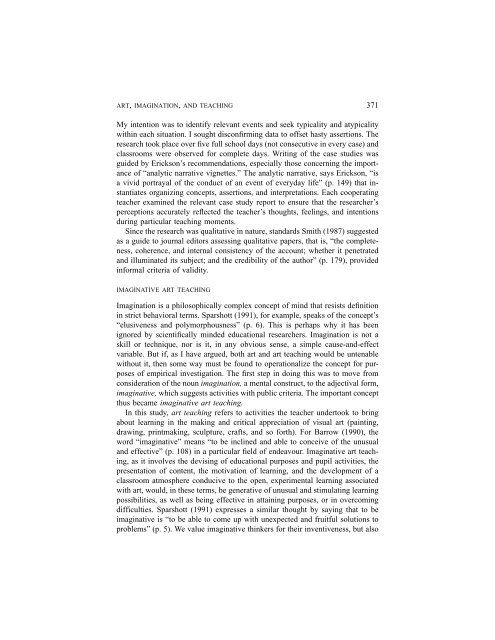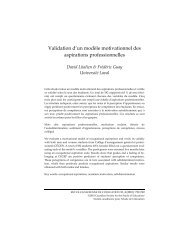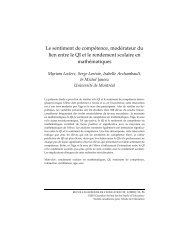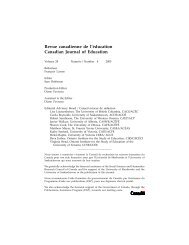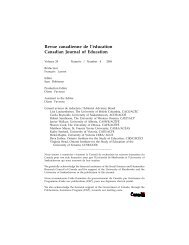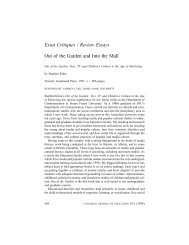Mireille Falardeau et Michel Loranger Le choix de stratégies ... - CSSE
Mireille Falardeau et Michel Loranger Le choix de stratégies ... - CSSE
Mireille Falardeau et Michel Loranger Le choix de stratégies ... - CSSE
Create successful ePaper yourself
Turn your PDF publications into a flip-book with our unique Google optimized e-Paper software.
ART, IMAGINATION, AND TEACHING 371<br />
My intention was to i<strong>de</strong>ntify relevant events and seek typicality and atypicality<br />
within each situation. I sought disconfirming data to offs<strong>et</strong> hasty assertions. The<br />
research took place over five full school days (not consecutive in every case) and<br />
classrooms were observed for compl<strong>et</strong>e days. Writing of the case studies was<br />
gui<strong>de</strong>d by Erickson’s recommendations, especially those concerning the importance<br />
of “analytic narrative vign<strong>et</strong>tes.” The analytic narrative, says Erickson, “is<br />
a vivid portrayal of the conduct of an event of everyday life” (p. 149) that instantiates<br />
organizing concepts, assertions, and interpr<strong>et</strong>ations. Each cooperating<br />
teacher examined the relevant case study report to ensure that the researcher’s<br />
perceptions accurately reflected the teacher’s thoughts, feelings, and intentions<br />
during particular teaching moments.<br />
Since the research was qualitative in nature, standards Smith (1987) suggested<br />
as a gui<strong>de</strong> to journal editors assessing qualitative papers, that is, “the compl<strong>et</strong>eness,<br />
coherence, and internal consistency of the account; wh<strong>et</strong>her it pen<strong>et</strong>rated<br />
and illuminated its subject; and the credibility of the author” (p. 179), provi<strong>de</strong>d<br />
informal criteria of validity.<br />
IMAGINATIVE ART TEACHING<br />
Imagination is a philosophically complex concept of mind that resists <strong>de</strong>finition<br />
in strict behavioral terms. Sparshott (1991), for example, speaks of the concept’s<br />
“elusiveness and polymorphousness” (p. 6). This is perhaps why it has been<br />
ignored by scientifically min<strong>de</strong>d educational researchers. Imagination is not a<br />
skill or technique, nor is it, in any obvious sense, a simple cause-and-effect<br />
variable. But if, as I have argued, both art and art teaching would be untenable<br />
without it, then some way must be found to operationalize the concept for purposes<br />
of empirical investigation. The first step in doing this was to move from<br />
consi<strong>de</strong>ration of the noun imagination, a mental construct, to the adjectival form,<br />
imaginative, which suggests activities with public criteria. The important concept<br />
thus became imaginative art teaching.<br />
In this study, art teaching refers to activities the teacher un<strong>de</strong>rtook to bring<br />
about learning in the making and critical appreciation of visual art (painting,<br />
drawing, printmaking, sculpture, crafts, and so forth). For Barrow (1990), the<br />
word “imaginative” means “to be inclined and able to conceive of the unusual<br />
and effective” (p. 108) in a particular field of en<strong>de</strong>avour. Imaginative art teaching,<br />
as it involves the <strong>de</strong>vising of educational purposes and pupil activities, the<br />
presentation of content, the motivation of learning, and the <strong>de</strong>velopment of a<br />
classroom atmosphere conducive to the open, experimental learning associated<br />
with art, would, in these terms, be generative of unusual and stimulating learning<br />
possibilities, as well as being effective in attaining purposes, or in overcoming<br />
difficulties. Sparshott (1991) expresses a similar thought by saying that to be<br />
imaginative is “to be able to come up with unexpected and fruitful solutions to<br />
problems” (p. 5). We value imaginative thinkers for their inventiveness, but also


